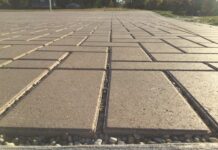Dwayne Lewis, president and owner of Lewis Block & Supply in Kansas City, Missouri, describes his company as “just the wall sub” for Notre Dame de Sion High School’s new soccer stadium.
Others might choose to disagree, including the judges for the 2016 Hardscape North America (HNA) competition. The approximately 18,000-square-foot project was recognized as the top segmental retaining walls – commercial project at the show in Louisville, Kentucky.
Lewis is simply surprised and grateful for the award. Surprised because when it was completed in July 2015, it was the largest project his company had done to that point. And, grateful for what he describes as a pretty good team, from the general contractor, to a building inspector, to Pavestone, to his own crew.

He says he may not have even been the lowest bidder on the project. Almost a decade ago, when he was first starting in business, he developed a relationship with the owner of Kissick Construction Company Inc., the general contractor for the job. And, he says, after showing Kissick what Lewis Block could do, the jobs kept getting bigger.
“When this project came along, they had to go out for bids, but I think I probably had somewhat of an inside track,” Lewis says. “They know who I am and what I’m capable of.”

The scope of the project was significant. Lewis says the high school had a soccer field where an ill-placed kick would send the ball down a hill and into traffic.
“It wasn’t very conducive for them,” he explains. “They wanted a stadium, so they had a fund-raising project and what we did was turn this piece of ground into a nice, flat piece of real estate with a wall around it and artificial turf. It’s really quite impressive.”

His biggest regret: he couldn’t sell the designers on using wall blocks for the seating, as well.
Once the architects knew what they wanted the wall to look like, Lewis brought in Pavestone, with whom he says he has a good working relation, to help him work through the project.
“I brought them to some of the planning meetings with me so they could hear what the engineer was looking for,” Lewis says. “Then, Pavestone and I worked to find a product they needed at a price I could make work for the bid I had in.”

Ultimately, the project was done in Pavestone Anchor Diamond Pro sand blocks.
Nor did Pavestone’s help stop there. Lewis admits to being proud of the fact that it was the largest project his firm at done to that time – but, going in, he also had some concerns about embarking on such a large project.
“When I was first awarded the project, they flew in an expert from Texas who had years and years of wall-building experience to come out and talk to me,” he says. “We went to the jobsite before we even got started, and he had suggestions and feedback that was invaluable to me in terms of putting me at ease about getting started with the project.”

He’s also proud of the way his crew – which varied from six to nine people over the seven-month project – performed.
“There just didn’t seem to be many hiccups,” Lewis says. “There’s always going to be an issue or two, but they worked well together and proved to themselves that we could do this.”
Of course, he also gives a lot of credit to Kissick, the general contractor.

“They knew what we were trying to accomplish, they knew what the schedule was and they did a really nice job as far as staying out in front of us,” Lewis says. “When we were within a day or two of finishing a wall, they had the footings and everything done and ready for us to go on to the next one. There wasn’t any delay.”
Not that everything went smoothly, of course. The job started December 23, 2014, so winter weather conditions were definitely a concern.
“It was a fairly mild winter, but there were still shutdowns,” he says. “We’d go back out there, and it was always a question mark after a freeze whether we were thawed enough to backfill the walls and make sure our grid zones were tight.”
He praises the inspector who was out there for most of the project and who made it easy to determine when it was possible to move forward without compromising the integrity of a wall.

The success of the job has also let Lewis and his management team “see the art of the possible.” He says that team did a great deal of post-analysis on the project, and for the most part liked what they saw.
“We’d love to have five or six of these jobs a year, but not that many jobs of this size come along,” he says. “What’s comforting is we know how to gear up, and we know we have the tools and the equipment so if a job like this comes along it’s not a question of ‘Should we do it?’ or ‘Can we do it?’ now, it’s a matter of ‘Of course; when do you need us to mobilize?’”
Besides that new-found confidence, Lewis admits to being thrilled with the HNA award. Still, he says it’s important to remember that his walls aren’t the main attraction in this, and Kissick and Notre Dame de Sion deserve the bulk of the credit.
“I’m the proud uncle who stands in the back and smiles because I had a part in it,” he concludes. “But, I can’t take credit for something they envisioned long before they ever hired me.”











![[VIDEO] Dickies®: Discover Workwear That’s Anything But Uniform](https://turfmagazine.com/wp-content/uploads/2023/06/1647663814-4b1a2a7742790a9b1e97a3b963477850192e1d6a9dfba9b07214a77bae25d6e3-d-218x150.jpg)






























![[VIDEO] Dickies®: Discover Workwear That’s Anything But Uniform](https://turfmagazine.com/wp-content/uploads/2023/06/1647663814-4b1a2a7742790a9b1e97a3b963477850192e1d6a9dfba9b07214a77bae25d6e3-d-324x160.jpg)